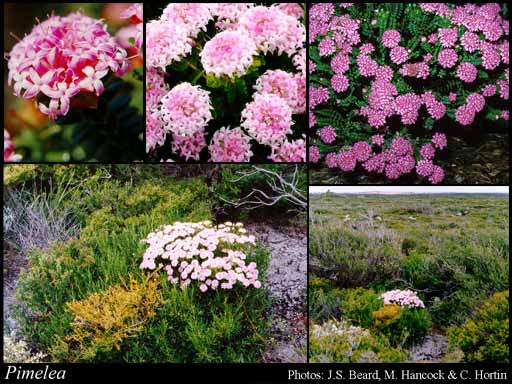- Reference
- Fruct.Sem.Pl. 1:186 (1788)
- Name Status
- Current

Scientific Description
Common name. Riceflowers. Family Thymelaeaceae.
Habit and leaf form. Shrubs, or herbs. Herbs annual. Mesophytic, or xerophytic. Leaves small to medium-sized; alternate (sometimes), or opposite; sometimes spiral; decussate; ‘herbaceous’, or leathery (sometimes ericoid); petiolate, or sessile; gland-dotted, or not gland-dotted; simple. Leaf blades entire; flat, or rolled; elliptic, or oblong, or ovate, or obovate, or linear, or orbicular; pinnately veined; cross-venulate. Leaves without stipules; without a persistent basal meristem. Leaf anatomy. Hairs present, or absent.
Reproductive type, pollination. Fertile flowers hermaphrodite, or functionally male and functionally female, or functionally male, or functionally female. Unisexual flowers present, or absent. Plants hermaphrodite (flowers protandrous), or monoecious, or dioecious (male flowers are not or only slightly enlarged at the base of the hypanthium and are usually longer than the female flowers, pistillode not exserted), or gynodioecious (female flowers often have a more prominently exserted style than the bisexual flowers and have small staminodes). Female flowers with staminodes. Male flowers with pistillodes.
Inflorescence and flower features. Flowers solitary, or aggregated in ‘inflorescences’; in racemes, or in heads, or in fascicles (or clusters). The terminal inflorescence unit racemose. Inflorescences terminal, or axillary; peduncle not expanded at apex or with a convex or rarely concave receptacle; inflorescence usually a very condensed terminal raceme, rarely elongate or of axillary clusters; with involucral bracts (bracts 4 or more, sessile); pseudanthial, or not pseudanthial. Flowers pedicellate. Pedicels terete. Flowers bracteolate, or ebracteolate; regular. Floral receptacle markedly hollowed (often forming a deep tube of leafy consistency). Free hypanthium present; usually with a fusiform ovary-portion, and a narrower, often cylindrical style-portion which is usually partly or fully persistent in fruit. Hypogynous disk present, or absent; when present, of separate members, or annular. Perianth sepaline (the corolla missing, the ‘calyx’ commonly more or less petaloid); 4; 1 -whorled; sepaloid, or petaloid. Calyx present; 4; 1 -whorled; polysepalous, or gamosepalous; blunt-lobed; imbricate; tubular; unequal but not bilabiate, or regular; green, or white, or cream, or yellow, or red, or pink, or brown; (tube) persistent. Corolla absent. Fertile stamens present, or absent (from female flowers). Androecial members definite in number. Androecium 1–2. Androecial members free of the perianth, or adnate; all equal; free of one another. Androecium exclusively of fertile stamens. Stamens (1–)2; attached inside the hypanthium, or attached on the rim of the hypanthium; all more or less similar in shape; reduced in number relative to the adjacent perianth; oppositisepalous; filantherous, or with sessile anthers. Anthers dehiscing via longitudinal slits; introrse; tetrasporangiate. Fertile gynoecium present, or absent (from male flowers). Gynoecium 2 carpelled (1 aborting early). The pistil 1 celled. Carpels reduced in number relative to the perianth. Gynoecium syncarpous; eu-syncarpous; superior. Ovary unilocular; 1 locular (at maturity). Gynoecium stylate. Styles 1; apical, or lateral. Stigmas 1. Placentation parietal, or apical. Ovules in the single cavity 1; pendulous; epitropous; with ventral raphe; arillate (or carunculate); anatropous, or hemianatropous.
Fruit and seed features. Fruit fleshy, or non-fleshy; indehiscent; achene-like, or a berry, or a drupe. Seeds endospermic, or non-endospermic. Cotyledons 2 (flat, expanded). Embryo straight.
Etymology. From the Greek for "fat"; derivation not stated; may refer to the fleshy cotyledons or to the oily seeds.